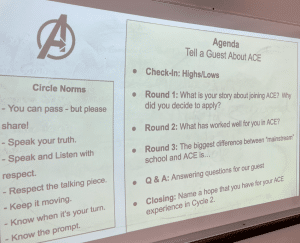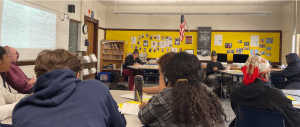Culture is the Foundation: Building Relationships and Community at ACE
CompetencyWorks Blog
At the Alternative Choices in Education (ACE) Program at Brookline HS, relationships and community are the foundation of a learning culture that centers the needs of learners. From the moment I entered the ACE corner of the big, comprehensive high school within which it is housed, I felt the connections between people at ACE.
On its website, ACE describes itself as “an innovative, competency-based program at Brookline High School for up to 48 [now 55] students, entering grades 10-12, who feel they will find more intellectual satisfaction and be more academically successful in a non-traditional setting.” At ACE, the learning experience design starts with a culture that develops the whole child and their agency as learners and humans. 
One of the founding teachers, Ben, reflected that “I wanted to do something different. I feel like everybody talks about how education doesn’t work and has been the same forever. But they are still sticking with the same archetype and trying to put a few patches on what is a boat made of swiss cheese and we need a new boat.” This post explores the key structures and practices around community initiatives, advisory, and the use of time and space at ACE. Together, they intentionally foster the relationship and community development that shapes the learning experience and builds “a new boat.”
Community by Design
As I enter into the ACE space, there are boards for work-based experiences, graduate legacy projects, and a tree poster from last Thanksgiving with notes of gratitude and appreciation on colorful paper leaves. Each classroom has varied spaces with typical classroom furniture, such as tables and chairs, and also comfy bean bag couches and carpets. Students pop into the office where there is a table with leftover donuts from the teacher focus group interview I conducted; they share when it gets to the last one.
ACE cultivates a community culture with intention. When a student officially joins the ACE program, the first time students and teachers spend time together is not in the school setting. As Laura Honeywood, the social studies teacher shares, “Our first experience with students is not in the classroom. We start with a ropes course. So our first interaction is getting to know each other as human beings and having fun while working as a team.”
There are lots of opportunities to connect among teachers and students both within and beyond classroom time and advisory. Community initiatives include community service, family events, community meetings, and fun outings like ice skating, going to a trampoline park, or seeing a movie. The week of Thanksgiving starts with two days of community service. Then, on the final half day, everyone gathers back at school for reflection, gratitude, and celebration. There is a fun, community-building field trip in February every year to break up the winter and encourage student connection. The ACE Student Leadership Team, composed of self-selected student leaders, meets weekly to organize, fundraise, lead, and emcee ACE community gatherings.
Advisory Dedicated to Developing as a Person
My visit schedule includes two visits to advisories. Advisory is a structure that is also in the larger high school, but at ACE, advisories meet twice a week rather than once, and for a bit longer time. One teacher describes advisory as “a real class dedicated to them as a person.” Teachers double as ACE advisors for 12-14 students during their entire time in the program.

Advisory provides a key space and structure for building the relationships that are foundational to creating a supportive learning environment. Circle Practice is intentionally used as a way to foster a sense of safety and connection on a regular basis. If a student breaks that safety or trust, a restorative justice circle is offered which uses the same circle practice that students are already familiar with and accustomed to using from advisory.
Students in one advisory welcome me for a focus group discussion. Multiple students say that the social aspects of being in a smaller community that prioritizes connectedness is a key reason they chose ACE and is a highlight of their experience. They talk about the importance of teacher attention and support, describing how teachers bring energy into their work and “don’t want you to fail.”

The other advisory that I join starts with singing happy birthday to the teacher. There is cake and a pumpkin pie that she brought for later. The group has named themselves the “Tree Huggers.” In one corner of the room an elaborate tree with a cozy nook in the trunk offers a physical embodiment of the group. Today a student is leading the group. Later I get a chance to chat with the student leader during her science class and she tells me that each student will get a turn to lead and frame the questions. We sit in a circle and I am welcome as a participant for the day. The student prepared a slide deck with several rounds of questions about how we value money. Since I am a guest, we start with a round of names and pronouns and share how we are feeling today on a scale of 1-10.
The ACE Habits of Success (HOS), which are a key feature of the program interwoven throughout, anchor goal setting and reflection in Advisory. There are 7 HOSs: curiosity, perseverance, collaboration, goal setting, self-regulation, self-awareness & reflection, and community-mindedness. Advisors work with their advisees 1:1 to help them pick a HOS to work on for the semester. Each student then maps out a HOS Action Plan to spell out how they will work on a specific aspect of that HOS and how they will hold themselves accountable for working on it.
Structures and Systems Support Connection
A number of design features support the opportunity to build relationships and community. For students who come to ACE in their 10th grade year, students and teachers have three years to build relationships and to grow together over time. While it could be a drawback for a student who is struggling, in contrast to full and half-year courses in the regular program, ACE’s organization of the curriculum into six-week classes, which I will delve into further in a future post, offers opportunities for fresh starts on a regular basis. Having students for three years balanced with the structure of shorter courses provides both a sense of belonging and being known and multiple opportunities to engage in learning.
In addition to the in-class interactions, the staff meets twice a week for case conference meetings, one for any student and one for students with Individualized Education Plans (IEPs). In these meetings, the program coordinator and teachers discuss students who are struggling and why. They share examples of what works for them in different classes and situations. They identify ways they can provide or get them additional support. The humanities teacher, Honeywood, shares, “I really love knowing my students and being able to talk to families at an IEP and being able to say what’s actually going on with a kid. Or having a parent say, ‘Agh, the kid is late, what are we going to do?’ and then being able to think with a parent about that kid specifically. I hope to continue to get better at observing and targeting my instruction to specific kids’ needs.”
The program coordinator of ACE, Amy Bayer, models the belief in the students and the culture of knowing them well. One teacher reflects, “We have exceptional leadership in our director. I can’t imagine our director ever letting me give up on a kid or imagine her giving up on a kid. It’s just not an option.”
Carrying Connection and Relevance into Learning

The connectedness continues into the learning. In the classes I observed, the students are both relaxed and engaged. The thematic curriculum emphasizes relevance. In the Dramatic Literature class, they are mapping characters and key moments from a play they went to see live. In the Ecosystems class, students work on a food webs project that will culminate with an option to make the food for which they chose to research the food chain. If the exemplars students show me when I ask what they are working on are any indication, presentation day will be filled with delicious dumplings and other foods that matter to the students in their lives. This class project further combines relationship-building with learning, which feels like the rule and not the exception at ACE.
The community and culture shape and intersect with the learning process and outcomes both within classes and beyond. Exhibitions – which happen twice a year for sophomores and juniors and three times for seniors – connect students who have experienced the process with newcomers in a buddy system. ACE frames the senior capstone experience as a legacy project reflecting the encouragement to contribute through their learning.
Framing Matters
When the ACE program was redesigned to be competency-based in 2015, it became a program of choice, rather than a program students were recommended for as a last option when they weren’t finding success in the mainstream high school. Communication about the ACE program happens in multiple spaces with a 9th grade assembly, info nights, and an opportunity to visit classes. There is currently a waitlist for ACE and each family and student enters with a clear idea of why and how ACE will work for the student.
In a community that values high achievement, ACE wants to communicate that its approach is different and at least as rigorous. By knowing each student, they can design their curriculum – which goes deeper into thematic topics – to tap each student’s strengths and offer ways to strengthen their weaker skill areas. ACE staff calibrate with student work to ensure that they know that a student has learned. This raises the standard of performance and goes hand in hand with the culture of knowing people, which well allows teachers to support students to learn and demonstrate that high standard.
Learner-centered, competency-based education (CBE) shifts our focus from a standardized covering of the curriculum based on time to meeting learners where they are in their learning and progressing based on mastery. Technical changes drive the redesign of structures and pedagogy, but underlying all of the technical change is a culture built on adaptive changes in our mindsets about the purpose of education. Creating a sense of belonging is the foundation for learning and a key element of competency-based learning and the learning sciences. At the ACE program, a culture where students are known and connected flourishes.
Learn More
- The Primary Person Model and Transformative Learning Experiences at Opportunity Academy
- Key Findings: Science of Learning and Development
- When Reinventing Schools, Don’t Relegate Relationships
Laurie Gagnon is the Aurora Institute’s CompetencyWorks Program Director.